Coordination and modulation of locomotion pattern generators in Drosophila larvae: effects of altered biogenic amine levels by the tyramine beta hydroxlyase mutation
- PMID: 16452672
- PMCID: PMC2673197
- DOI: 10.1523/JNEUROSCI.4749-05.2006
Coordination and modulation of locomotion pattern generators in Drosophila larvae: effects of altered biogenic amine levels by the tyramine beta hydroxlyase mutation
Abstract
Forward locomotion of Drosophila melanogaster larvae is composed of rhythmic waves of contractions that are thought to be produced by segmentally organized central pattern generators. We present a systematic description of spike activity patterns during locomotive contraction waves in semi-intact wild-type and mutant larval preparations. We have shown previously that Tbetah(nM18) mutants, with altered levels of octopamine and tyramine, have a locomotion deficit. By recording en passant from the segmental nerves, we investigated the coordination of the neuronal activity driving contraction waves of the abdominal body-wall muscles. Rhythmic bursts of activity that occurred concurrently with locomotive waves were frequently observed in wild-type larvae but were rarely seen in Tbetah(nM18) mutants. These centrally generated patterned activities were eliminated in the distal stumps of both wild-type and Tbetah(nM18) larvae after severing the segmental nerve from the CNS. Patterned activities persisted in the proximal stumps deprived of sensory feedback from the periphery. Simultaneous recordings demonstrated a delay in the bursting activity between different segments, with greater delay for segments that were farther apart. In contrast, bilateral recordings within a single segment revealed a well synchronized activity pattern in nerves innervating each hemisegment in both wild-type and Tbetah(nM18) larvae. Significantly, rhythmic patterns of bursts and waves could be evoked in Tbetah(nM18) mutants by head or tail stimulation despite their highly irregular spontaneous activities. These observations suggest a role of the biogenic amines in the initiation and modulation of motor pattern generation. The technique presented here can be readily extended to examine the locomotion motor program of other mutants.
Figures
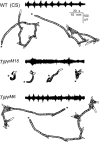
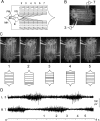



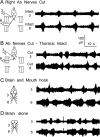
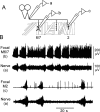
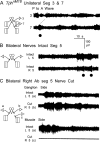
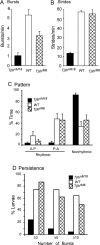
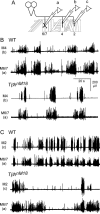
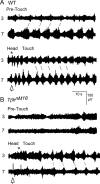
Similar articles
-
Tyramine and octopamine have opposite effects on the locomotion of Drosophila larvae.J Neurobiol. 2004 Mar;58(4):425-41. doi: 10.1002/neu.10298. J Neurobiol. 2004. PMID: 14978721
-
Flight initiation and maintenance deficits in flies with genetically altered biogenic amine levels.J Neurosci. 2007 Oct 10;27(41):11122-31. doi: 10.1523/JNEUROSCI.2704-07.2007. J Neurosci. 2007. PMID: 17928454 Free PMC article.
-
The role of octopamine and tyramine in Drosophila larval locomotion.J Comp Neurol. 2012 Nov 1;520(16):3764-85. doi: 10.1002/cne.23152. J Comp Neurol. 2012. PMID: 22627970
-
Biogenic amine systems in the fruit fly Drosophila melanogaster.Microsc Res Tech. 1999 Apr 15;45(2):106-21. doi: 10.1002/(SICI)1097-0029(19990415)45:2<106::AID-JEMT5>3.0.CO;2-3. Microsc Res Tech. 1999. PMID: 10332728 Review.
-
The CPGs for Limbed Locomotion-Facts and Fiction.Int J Mol Sci. 2021 May 30;22(11):5882. doi: 10.3390/ijms22115882. Int J Mol Sci. 2021. PMID: 34070932 Free PMC article. Review.
Cited by
-
Sensitivity to expression levels underlies differential dominance of a putative null allele of the Drosophila tβh gene in behavioral phenotypes.PLoS Biol. 2021 May 10;19(5):e3001228. doi: 10.1371/journal.pbio.3001228. eCollection 2021 May. PLoS Biol. 2021. PMID: 33970909 Free PMC article.
-
Effects of manipulating slowpoke calcium-dependent potassium channel expression on rhythmic locomotor activity in Drosophila larvae.PeerJ. 2013 Mar 26;1:e57. doi: 10.7717/peerj.57. Print 2013. PeerJ. 2013. PMID: 23638395 Free PMC article.
-
Drosophila larval motor patterning relies on regulated alternative splicing of Dscam2.Front Mol Neurosci. 2024 Jul 18;17:1415207. doi: 10.3389/fnmol.2024.1415207. eCollection 2024. Front Mol Neurosci. 2024. PMID: 39092203 Free PMC article.
-
Distinct frequency-dependent regulation of nerve terminal excitability and synaptic transmission by IA and IK potassium channels revealed by Drosophila Shaker and Shab mutations.J Neurosci. 2006 Jun 7;26(23):6238-48. doi: 10.1523/JNEUROSCI.0862-06.2006. J Neurosci. 2006. PMID: 16763031 Free PMC article.
-
Interspecies variation of larval locomotion kinematics in the genus Drosophila and its relation to habitat temperature.BMC Biol. 2021 Sep 2;19(1):176. doi: 10.1186/s12915-021-01110-4. BMC Biol. 2021. PMID: 34470643 Free PMC article.
References
-
- Alkema MJ, Hunter-Ensor M, Ringstad N, Horvitz HR (2005). Tyramine functions independently of octopamine in the Caenorhabditis elegans nervous system. Neuron 46:247–260. - PubMed
-
- Baier A, Wittek B, Brembs B (2002). Drosophila as a new model organism for the neurobiology of aggression? J Exp Biol 205:1233–1240. - PubMed
-
- Barclay JW, Atwood HL, Robertson RM (2002). Impairment of central pattern generation in Drosophila cysteine string protein mutants. J Comp Physiol A Neuroethol Sens Neural Behav Physiol 188:71–78. - PubMed
-
- Belanger JH, Trimmer BA (2000). Combined kinematic and electromyographic analyses of proleg function during crawling by the caterpillar Manduca sexta. J Comp Physiol A Neuroethol Sens Neural Behav Physiol 186:1031–1039. - PubMed
-
- Berrigan D, Pepin DJ (1995). How maggots move: allometry and kinematics of crawling in larval diptera. J Insect Physiol 41:329–337.
Publication types
MeSH terms
Substances
Grants and funding
LinkOut - more resources
Full Text Sources
Molecular Biology Databases
Research Materials
